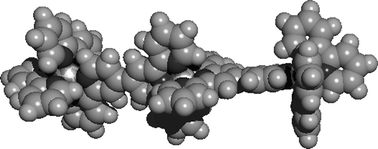Electrochemical probing of ground state electronic interactions in polynuclear complexes of a new heteroditopic ligand
Abstract
The synthesis and electronic properties of dinuclear ([(bipy)2Ru(I)M(terpy)][PF6]4 (bipy = 2,2′-bipyridine, terpy = 2,2′:6′,2″-terpyridine; M = Ru, Os)) and trinuclear ([{(bipy)2Ru(I)}2M][PF6]6 M = Ru, Os, Fe, Co) complexes bridged by 4′-(2,2′-bipyridin-4-yl)-2,2′:6′,2″-terpyridine (I) have been investigated and are compared with those of mononuclear model complexes. The electrochemical analysis using cyclic voltammetry and differential pulse voltammetry reveals that there are no interactions in the ground state between adjacent metal centres. However, there is strong electronic communication between the 2,2′-bipyridine and 2,2′:6′,2″-terpyridine components of the bridging ligand. This conclusion is supported by a step-by-step reduction of the dinuclear and trinuclear complexes and the assignment of each electrochemical process to localised ligand sites within the didentate and terdentate domains. The investigation of the electronic absorption and emission spectra reveals an energy transfer in the excited state from the terminating bipy-bound metal centres to the central terpy-bound metal centre. This indicates that the bridge is able to facilitate energy transfer in the excited state between the metal centres despite the lack of interactions in the ground state.


 Please wait while we load your content...
Please wait while we load your content...